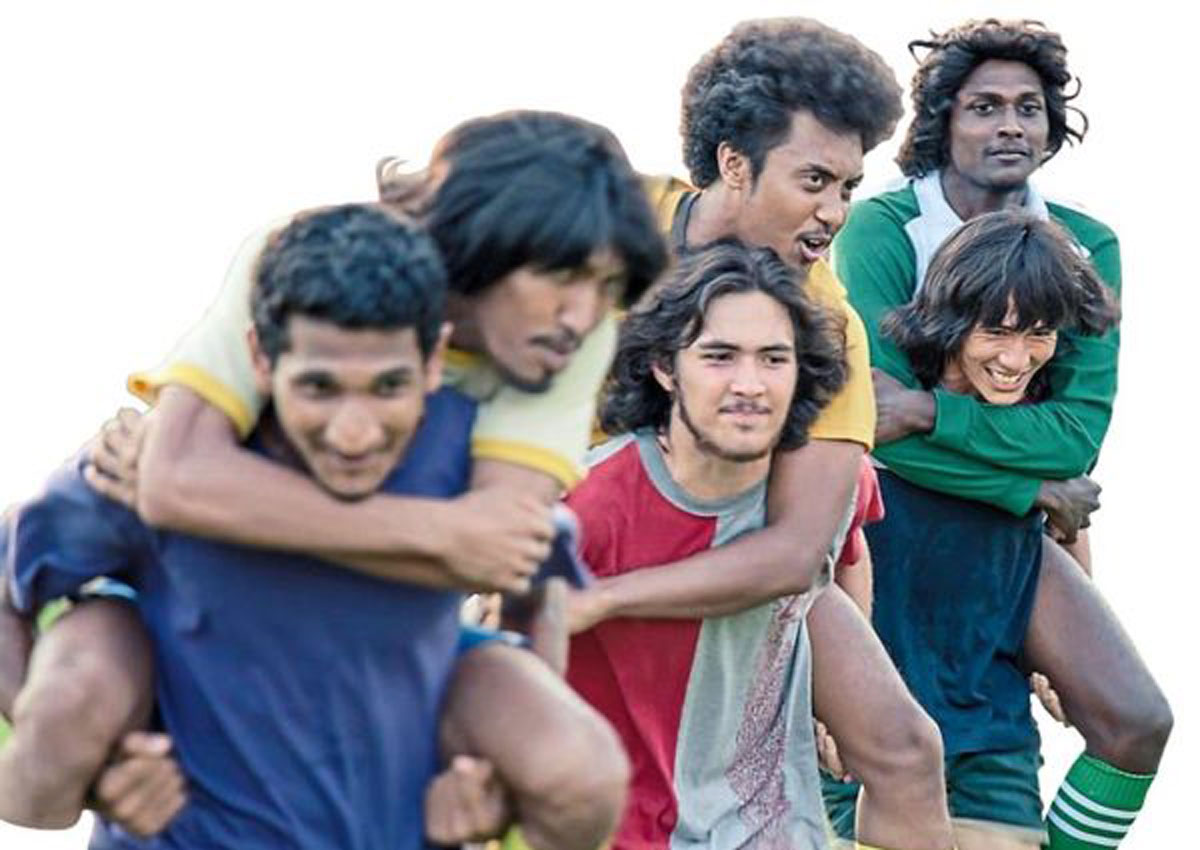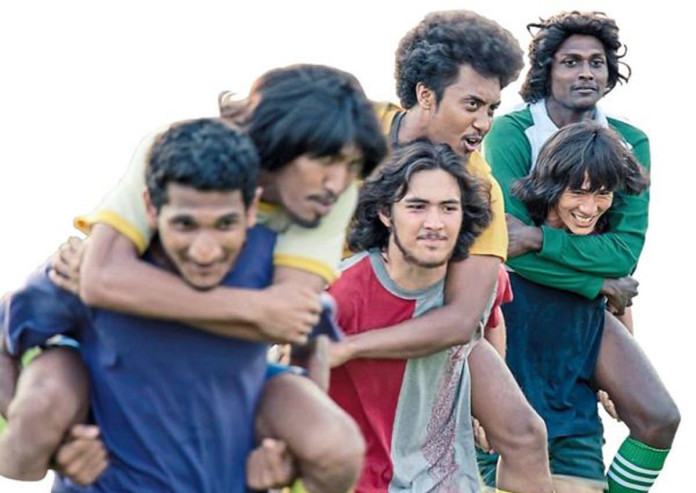AN old Chinese uncle and his future gwailo son-in-law, a mixed couple having cold feet on their wedding day, a poor Indian boy from rural Malaysia, the Chinese captain of the 1980 Harimau Malaya team and a super kid who battles aliens with his multi-racial geng…
It has been a colourful few years for our film scene with its diverse array of characters and stories. If life was like the movies, one could even say, to borrow OlaBola’s tagline, “You will believe again”.
As Hollywood continues to be embroiled in a heated “diversity” debate, it is interesting to see our own film industry faring not too badly in the plurality stakes.
To take a slice of J.J. Abrams’ wisdom: diversity is “people see(ing) themselves represented in film”.
Of course, Abrams is the director who dared to test fans’ tolerance by casting a young woman, Daisy Ridley, in the lead Jedi role and a black actor, Jack Boyega, as what many are calling the Han-Solo-heir-apparent-character, Finn, in the Star Wars reboot.
It is clear he believes diversity is not just good, but good for business, as he told Hollywood Reporter after introducing a new policy at his company Bad Robot to increase women and minorities in film: “We’re working to find a rich pool of representative, kick-a** talent and give them the opportunity they deserve… It’s good for audiences and it’s good for the bottom line.”
It appears that diversity has boosted our films’ bottom line too – after a dry spell at the box office, Malaysian films scored big with local Chinese film The Journey and Polis Evo (a Malay film written by a mixed writing trio, Joel Soh, Kyle Goonting and Anwari Ashraf) and OlaBola – The Journey director Chiu Keng Guan’s follow-up. Local horror film Munafik may yet trump all in its ticket sales, but this only shows that there is room for all in our movie landscape, including your conventional Malay movie.
As director Liew Seng Tat points out, it’s not just about race when talking about diversity.
“It should also be about the different kinds of Malaysian voices and stories.
“There are many groups of people making different types of films in Malaysia now, I know they are serious about making good films and they want to change the film scene,” he says.
Just check out the eclectic list of winners at last year’s Malaysian Film Festival (FFM): the Best Picture award went to Liew’s Lelaki Harapan Dunia, for which he also won Best Director.
The Journey’s Frankie Lee bagged the Best Actor award, while Dawn Chong clinched the Most Promising Actress award for her role in Cuak, a film about an interracial couple that was shot mainly in English.
What’s more, Cuak was the collaborative product of five young directors and a mixed team of writers and actors.
Being rewarded at the FFM is encouraging, says Liew.
“It encourages those of us who want to make ‘different’ kinds of films to keep doing it. I don’t know who was in the FFM jury panel but whoever they are it’s clear they didn’t want to play safe either and wanted something new.”
He points at Kil by Nik Amir Mustapha, which won not just the Best Picture award the year before that, but also Best Director and Best Screenplay.
“People behind Kil were all new, and it was great to see Finas and the local film industry recognise this new voice and people who are doing it a bit differently,” he says.
True, from its storyline alone, Kil, which tells of a suicidal young man who hires a suicide agency to kill him off, is clearly not your typical Malaysian film. Nik Amir’s second outing Terbaik Dari Langit, which tells of a dying filmmaker going on a road trip with friends in search of aliens for his last hurrah, may have lost out on the major awards at the FFM last year but its fresh vibe won the hearts of new fans, especially those who don’t normally watch Malay or local movies.
Sadly, there is a blip in the colourful bright lights – many of these films have failed at the box office; many did not even break RM500,000 (S$171,740).
Now, another interesting new voice is feeling the same apathy at the theatre.
Redha, which opened on April 14, features a story yet seen on our local reels: autistic children and their family.
Having gotten attention from film fans across the race aisles, Redha is now down to a handful of screenings in the local circuit and has grossed only around RM150,000 to date.
Many of her friends had called her crazy for wanting to make a film on the complex neurodevelopment disorder, says a resigned Tunku Mona Riza, who wrote and directed Redha.
“So many people that I met had discouraged me. Don’t do it, they said. Malaysia is not ready for this. Who wants to watch a film on autism? ‘You are crazy, Mona… You are taking a risk,'” shares the former commercial director.
Although she initially could not get any investors for her film, she managed to get a Creative Industry Loan from BSN.
“The bank knew me because I had earlier made a commercial for them. So I proposed to them my idea; BSN CEO Datuk Adinan Maning and the bank’s committee listened to my pitch. To my surprise, the bankers liked the idea, they said the story has substance and I should do it,” she says.
Tunku Mona still believes Malaysia is ready for “difficult” topics on film.
“If you talk about autism, we have had many films on it from Hollywood, Bollywood, Hong Kong… they have done well.
“We have had all kinds of films from overseas and Malaysian film fans can accept them,” she says, adding that Redha really deals with the universal theme of love and family.
What is encouraging, she adds, is the opportunities for local women filmmakers.
“We have had quite a few successful female filmmakers here, but we should encourage and support more, especially young women, to tell their own stories,” she notes.
Aspiring scriptwriter June Tan agrees that as far as filmmaking opportunities go here, they should only get better.
“The Government has a lot of meaningful grants and programmes (for industry practitioners).
“I have never felt discriminated, but I think there is more work to do to provide support for women’s voices and stories,” says Tan, who received a Creative Lifelong Learning programme (Cill) grant from Finas to attend the Binger Lab in Amsterdam, which is a workshop for producers and writers.
The scene is buzzing, she muses.
“Many people I know in the scene, from producers to directors, seem to have many different, exciting projects boiling.
“Everyone’s tired of the same characters and stories. Even actors – they are tired of playing the same roles and characters,” notes Tan, who was co-writer with Bunohan director Dain Said for his upcoming film Interchange.
Liew attributes the promising development for local films to Finas director-general Datuk Kamil Othman, who took over the post almost two years ago.
“The Finas D-G is doing a good job in developing new and young voices in Malaysian film – that’s why these diverse voices are obvious now in the local film landscape.
“Datuk Kamil is not just visionary; he is a real film buff and really passionate about filmmaking,” he says.
One development that Liew believes will drive the rise of many more new and interesting voices is the Content Malaysia Pitching Centre, a platform for filmmakers to pitch ideas for funding. The hub, which opened in April last year, also holds various forums and workshops on directing and scriptwriting.
“If you go to the Pitching Centre you can see many filmmakers walking in and out. The centre’s people don’t care who you are – Malay, Chinese, Indian, male, female…
“As long as you have an interesting idea, they will support you. The whole pitching process is very straightforward and transparent.”
Now what is needed is for producers to get out of their comfort zone, Tan says.
“I think the bottleneck is really producers who don’t want to take risks. Many are clinging on to the idea that the audiences are not willing to accept changes. But I have to say that audiences will always surprise you.”
If we take the example of films that have seemingly crossed the boundaries of race like The Journey and OlaBola, we have to admit that they had the advantage of producers who were willing to put the money where it is needed – in marketing and promoting the films outside of their “normal” markets.
“I think if Polis Evo was promoted outside of the conventional Malay film market, it would have been a bigger hit,” Tan opines.
For most filmmakers, however, the issue is still the lack of funds to promote their film, what more to sell it beyond their guaranteed markets.
Local Tamil films, especially, are feeling the pinch.
As Malaysian Indian Artist Association chairman who goes by the stagename VJ Emergency puts it, more than 10 local Tamil movies were produced last year but they were not able to sell them to the local non-Indian market.
“We want to promote our films outside of the local Indian market, but it takes money. And we even have to compete against films from India,” he says.
Liew feels it is not only producers who need to think outside the race box but also film distributors and exhibitors.
“People who went to see OlaBola and The Journey did not see race. Those films’ success tells us that if we take away the racial barriers, we will see the migration of audiences across segments. If we erase them completely, the box office earnings will be even higher.”
This is essential as a film’s domestic box office gross informs foreign distributors in their decision whether to buy a film – the bigger a hit is locally, the more attractive it becomes to foreign buyers.
Liew proposes another diverse route – filmmakers making movies on communities not their own.
His own film Lelaki is shot in Malay and talks about the changing values of the Malay community. Revolving around the old Malay tradition of angkat rumah (where the whole kampung would get together to help carry a house when their neighbour wanted to move to a new place), Lelaki tells of Pak Awang who gets the whole kampung to angkat an abandoned house from the jungle as his daughter’s wedding gift. Surprise, surprise, he gets more than a house – hiding within it is an illegal African migrant on the run.
Liew believes making movies about the different communities of Malaysia, regardless of language and the ethnicity of the filmmaker can be a plus point in a multicultural country like ours.
“I think that is also ‘diversity’. You don’t have to spell it out on the screen. Plus, it was a good experience for me and my crew who were racially mixed and mainly urban to work in a Malay kampung,” he shares.
Of course, our local film industry has always been diverse since it started some 90 years ago, with many non-Malay and non-Malaysian players like the Shaw brothers and Tan Sri L. Krishnan, the Father of Malay Films.
Even today, we have many non-Malay filmmakers who have made a name in the mainstream Malay film scene like David Teo and Bernard Chauly. M. Subash Abdullah, has gone on to direct Chinese films You Believe In Ghost? and Karma Returns after cutting his teeth making Tamil and Malay films.
What we need now is for mainstream Malay filmmakers to venture out of their comfort zones by making films about the other communities and cultures in the country, as Kamil himself had urged after he took the helm of Finas.
Concurring, Liew says he is now thinking beyond language and beyond race.
“My intention is to draw audiences from all races. The easiest thing is to do a muhibbah film but I don’t want to go down that route, so my next film will be a Malaysian Chinese film. I know the only way I can attract non-Chinese audience to watch a local Chinese film is to make it entertaining and to make it good.”
Tunku Mona agrees.
“We hope people can change their mindset about Malaysian films and show support. Without a doubt, we have many good storytellers in the country and they have made good films, regardless of race and religion.
“You know they can push themselves further, and if they were given the support and exposure, I am sure our industry will grow.”







